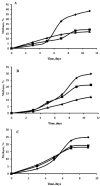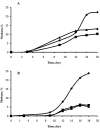The Effects of Perchlorates on the Permafrost Methanogens: Implication for Autotrophic Life on Mars
- PMID: 27682103
- PMCID: PMC5023257
- DOI: 10.3390/microorganisms3030518
The Effects of Perchlorates on the Permafrost Methanogens: Implication for Autotrophic Life on Mars
Abstract
The terrestrial permafrost represents a range of possible cryogenic extraterrestrial ecosystems on Earth-like planets without obvious surface ice, such as Mars. The autotrophic and chemolithotrophic psychrotolerant methanogens are more likely than aerobes to function as a model for life forms that may exist in frozen subsurface environments on Mars, which has no free oxygen, inaccessible organic matter, and extremely low amounts of unfrozen water. Our research on the genesis of methane, its content and distribution in permafrost horizons of different ages and origin demonstrated the presence of methane in permanently frozen fine-grained sediments. Earlier, we isolated and described four strains of methanogenic archaea of Methanobacterium and Methanosarcina genera from samples of Pliocene and Holocene permafrost from Eastern Siberia. In this paper we study the effect of sodium and magnesium perchlorates on growth of permafrost and nonpermafrost methanogens, and present evidence that permafrost hydogenotrophic methanogens are more resistant to the chaotropic agent found in Martian soil. In this paper we study the effect of sodium and magnesium perchlorates on the growth of permafrost and nonpermafrost methanogens, and present evidence that permafrost hydogenotrophic methanogens are more resistant to the chaotropic agent found in Martian soil. Furthermore, as shown in the studies strain M2(T) M. arcticum, probably can use perchlorate anion as an electron acceptor in anaerobic methane oxidation. Earth's subzero subsurface environments are the best approximation of environments on Mars, which is most likely to harbor methanogens; thus, a biochemical understanding of these pathways is expected to provide a basis for designing experiments to detect autotrophic methane-producing life forms on Mars.
Keywords: Mars; methanogenic archaea; perchlorates; permafrost.
Figures





Similar articles
-
Response of Methanogenic Archaea from Siberian Permafrost and Non-permafrost Environments to Simulated Mars-like Desiccation and the Presence of Perchlorate.Astrobiology. 2019 Feb;19(2):197-208. doi: 10.1089/ast.2018.1877. Astrobiology. 2019. PMID: 30742498
-
Survival of methanogenic archaea from Siberian permafrost under simulated Martian thermal conditions.Orig Life Evol Biosph. 2007 Apr;37(2):189-200. doi: 10.1007/s11084-006-9024-7. Epub 2006 Dec 12. Orig Life Evol Biosph. 2007. PMID: 17160628
-
Stress response of methanogenic archaea from Siberian permafrost compared with methanogens from nonpermafrost habitats.FEMS Microbiol Ecol. 2007 Jul;61(1):16-25. doi: 10.1111/j.1574-6941.2007.00316.x. Epub 2007 Apr 11. FEMS Microbiol Ecol. 2007. PMID: 17428303
-
Methanogens and what they tell us about how life might survive on Mars.Crit Rev Biochem Mol Biol. 2024 Oct;59(5):337-362. doi: 10.1080/10409238.2024.2418639. Epub 2024 Nov 3. Crit Rev Biochem Mol Biol. 2024. PMID: 39488737 Review.
-
Life on Mars: chemical arguments and clues from Martian meteorites.Extremophiles. 1998 Aug;2(3):313-9. doi: 10.1007/s007920050074. Extremophiles. 1998. PMID: 9783179 Review.
Cited by
-
An Antarctic Extreme Halophile and Its Polyextremophilic Enzyme: Effects of Perchlorate Salts.Astrobiology. 2018 Apr;18(4):412-418. doi: 10.1089/ast.2017.1766. Epub 2017 Nov 30. Astrobiology. 2018. PMID: 29189043 Free PMC article.
-
Methylocystis borbori sp.nov., a novel methanotrophic bacterium from the sludge of a freshwater lake and its metabolic properties.Antonie Van Leeuwenhoek. 2024 Nov 22;118(1):29. doi: 10.1007/s10482-024-02039-8. Antonie Van Leeuwenhoek. 2024. PMID: 39576297
-
Microbial Assemblages in Pressurized Antarctic Brine Pockets (Tarn Flat, Northern Victoria Land): A Hotspot of Biodiversity and Activity.Microorganisms. 2019 Sep 9;7(9):333. doi: 10.3390/microorganisms7090333. Microorganisms. 2019. PMID: 31505750 Free PMC article.
-
A New Record for Microbial Perchlorate Tolerance: Fungal Growth in NaClO4 Brines and its Implications for Putative Life on Mars.Life (Basel). 2020 Apr 28;10(5):53. doi: 10.3390/life10050053. Life (Basel). 2020. PMID: 32353964 Free PMC article.
-
Non-Psychrophilic Methanogens Capable of Growth Following Long-Term Extreme Temperature Changes, with Application to Mars.Microorganisms. 2018 Apr 23;6(2):34. doi: 10.3390/microorganisms6020034. Microorganisms. 2018. PMID: 29690617 Free PMC article.
References
-
- Cameron R.E., Morelli F.A. Viable microorganisms from ancient Ross Island and Taylor Valley drill core. Antarct. J. U. S. 1974;9:113–116.
-
- Gilichinsky D. Encyclopedia of Environmental Microbiology. Willey-Interscience; New York, NY, USA: 2002. Permafrost as a microbial habitat; pp. 932–956.
-
- Gilichinsky D.A., Wilson G.S., Friedmann E.I., McKay C.P., Sletten R.S., Rivkina E.M., Vishnivetskaya T.A., Erokhina L.G., Ivanushkina N.E., Kochkina G.A., et al. Microbial populations in Antarctic permafrost: Biodiversity, state, age, and implication for astrobiology. Astrobiology. 2007;7:275–311. doi: 10.1089/ast.2006.0012. - DOI - PubMed
LinkOut - more resources
Full Text Sources
Other Literature Sources
Molecular Biology Databases
Miscellaneous

